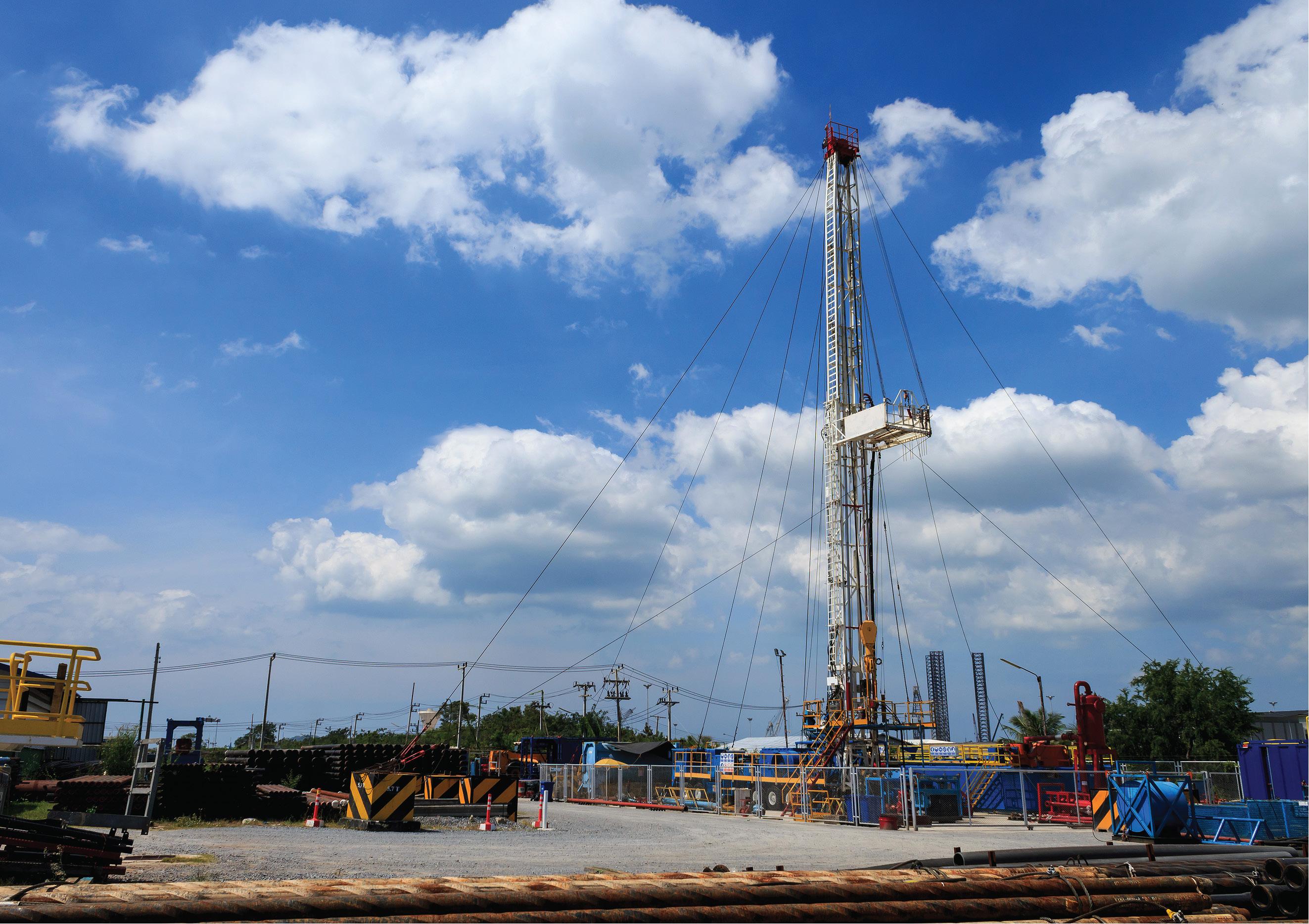

Edge
Computing Platforms Bring Intelligent Automation and New Efficiency to Upstream Oil & Gas



Participants across the Upstream value chain are turning to Edge Computing to scale automation and deploy Industry 4.0 capabilities to remote assets for reliability, insight, and safety.
Edge Computing Platforms Bring Intelligent Automation and New Efficiency to Upstream Oil & Gas
Introduction
The global exploration and production of oil and gas resources remains perhaps the most capital intensive, labor intensive, and sophisticated endeavor on the planet. Over the years, the industry has made massive strides to reduce costs, improve accuracy and efficiency, and increase safety through relentless innovation and deployment of new technology, from the introduction of 3D seismic analysis in the 1980s to the first steerable bottom-hole assemblies.
Modern Edge Computing now brings new possibility to add insight and intelligent automation to Upstream operations, providing the foundation to extend Deloitte’s original notion of the digital oilfield. Whereas other vertical industries are wakening to the practical challenges of limited connectivity, bandwidth, and limited IT staff, these challenges have been inherent in Upstream operations from the beginning.
This whitepaper discusses modern Edge Computing platforms and their application across the Upstream value chain for Owner-Operators, oilfield services (OFS) providers, oilfield equipment (OFE) manufacturers, and Engineering, Procurement & Construction companies (EPCs) to bring Industry 4.0 capabilities and new reliability to remote, stranded, and low-staffed assets that are high value and mission critical.
Operational Challenges in Upstream
Across the Upstream ecosystem, participants face pricing pressures and look to digital innovation for service differentiation, improved productivity, and new efficiencies to revolutionize cost structures and gain a competitive edge.
As Owner-Operators rationalize their asset portfolios and pursue strategies to drive cost improvement, with a focus on CapEx and OpEx discipline, it’s critical for them to build technical proficiency and partner with service providers, System Integrators (SIs), and EPCs fluent in the latest technologies. Conversely, service providers and manufacturers must deliver greater equipment reliability, meet project budgets, and ensure successful outcomes while exploring new service models.
Edge Computing provides numerous opportunities across the Upstream value chain for these participants to harness data from critical equipment and processes, quickly add smart capabilities to equipment, gain insight, and improve reliability to meet their goals around operational excellence, performance, safety, and cost.
Edge Computing Platforms: A Foundation for Upstream Digitalization
Edge Computing is a distributed information architecture to collect and process data at the furthest point a.k.a. “the edge” of a computer network, with limited or no connectivity to a centralized cloud or data center. Once acquired, data may be sent on-premises to a central control room or to the cloud for analysis and management. This close proximity to equipment reduces latency and balances bandwidth utilization, two factors that limit capability at the edge.
Edge Computing quickly brings intelligence to critical equipment, assets, and processes, in the form of compute platforms purpose-built for the industrial edge. These platforms transform the collection and processing of data from remote assets to form a foundation to enable an organization’s data management strategy. Organizations are then able to derive insight from this distributed computing model through local analytics on the Edge Computing platform for sharing to cloud or centralized networks, however intermittently, for visibility and deeper analysis.
Industrial Edge Computing platforms incorporate a redundant architecture to provide application fault tolerance and eliminate a single point of failure. They also deliver server performance in a ruggedized form factor ready for installation in Upstream directly alongside equipment at the well site or production platform. Edge Computing platforms purpose-built for the industrial edge may be installed and maintained by OT but meet IT requirements for interoperability and cybersecurity out-of-the-box. This ease of use is essential for the limited IT or OT staffing of Upstream locations.
Lastly, modern Edge Computing platforms provide highly efficient operations through virtualization, allowing multiple software applications to run on a single node backed by fault tolerance. These solutions simplify software deployment, reduce IT footprint and maintenance, and lower total cost of ownership.
Edge Computing Platforms Bring Intelligent Automation and New Efficiency to Upstream Oil & Gas
When deployed, Edge Computing platforms provide the foundation to connect sophisticated automation with enterprise-class software and analytics for reliability and insight. They are also a pre-requisite for advanced capabilities such as predictive analytics, Digital Twin, and other Industry 4.0 solutions that offer high value to remote Upstream environments.
Why Edge Computing Now
In many ways, the Oil & Gas industry has been digitized for some time. Downstream processes have benefited from an abundance of instrumentation, sensor data, process control, and now cloud connectivity, analysis, and data sharing. Edge Computing remains a critical complement to centralized cloud computing, but the opportunity to generate value from the edge is greatest in Upstream.
Upstream faces both the geographic remoteness and the need to digitalize information, but also massive data generation creating a data deluge from remote islands of automation. An offshore oil platform, for example, may generate 1-2 TBs of data per day with limited data capture, analysis, or sharing. In fact, a Cisco study1 reported that more than half of energy respondents cited the format, completeness, and accessibility of data in their firms as problematic. Deploying the local power of Edge Computing in Upstream enables the use of this data for local analysis and transport, as connectivity allows.
Moreover, Edge Computing allows Upstream companies to build computing infrastructure to harness data to bring intelligent automation to the oilfield. This includes the deployment of advanced capabilities enabled by artificial intelligence and machine learning such as autonomous operations that remove individuals from hazardous environments or further streamline Upstream operations.
Opportunities at the Edge
The application of Edge Computing opens new possibilities to optimize drilling, production, enhanced recovery, and other oilfield operations in any context – onshore, offshore, subsea, and topside as well as related marine operations – while reducing cost and improving safety.
1Cisco, New Realities in Oil and Gas: Data Management and Analytics, 2017.
Examples include:
Subsea Asset Management
Asset Performance Management
Compressor Optimization
Gas Lift Optimization
Predictive Maintenance
Autonomous Drilling
Barriers to Digitalization and Intelligent Automation: Availability of Edge Data
Research shows that the use of digital technologies has the potential to unlock up to $1.6 trillion of value for Oil & Gas companies, their customers, and society as a whole by 2025.2 To realize the value of these new digital technologies, Upstream operators must overcome the logistical and technical challenges of extracting data from remote equipment.
Logistical challenges of digitalization include:
Locations are remote with limited accessibility for personnel to implement and maintain IT systems
Environments are rugged and ill-suited for typical IT equipment
Production and automation equipment at well sites is a mix of new and old
Well site functions call for extensive automation and compute capability
General desire to minimize human operator trips to sites
Technical challenges to solve for include:
Latency introduced by bandwidth constraints and limited communications infrastructure associated with stranded assets in remote operating environments
Congestion of existing networks hinders ability to use real-time data for time-dependent analysis for decision making and predictive value
Delay of decision created by transport to control centers and data centers miles from critical assets
Cybersecurity concerns created by remote OT and IoT devices
Edge Computing presents Upstream companies with the opportunity to acquire, connect, and analyze data from the wellhead to storage to optimize operations.
Edge Computing Platforms Bring Intelligent Automation and New Efficiency

The newest Edge Computing platforms solve prior logistical and technology challenges, and enable efficient acquisition of real-time data to accelerate digitalization in Upstream to deliver: Edge Requirements for Digitalization in Upstream
New levels of equipment reliability and availability: Edge Computing platforms deliver built-in fault tolerance in ruggedized form factors for the industrial edge. Currently many high-value, mission-critical applications are run with basic IPCs unable to deliver the level of reliability required for remote assets. In contrast, Edge Computing platforms are built for zero downtime without reliance on IT for maintenance and support.
Zero-touch operation and remote management: With limited support staff and access, Upstream operators require computing platforms that may be managed remotely to run software and equipment continuously. Additionally, proactive health monitoring, alerting, patching, and issue resolution must be handled remotely, often by OT rather than IT.
Convergence of OT and IT: With limited IT resources, the responsibility for managing critical infrastructure increasingly falls to the OT teams who manage SCADA, DCS, and PLCs. As those teams increase responsibility for deploying new applications and IT architecture themselves, they require systems easy to provision without IT support. Edge computing platforms must be built for OT applications and serviceable by those teams.
Future proof technology to support Upstream asset lifecycles: Wellheads may produce for decades whereas automation technology and traditional IT infrastructure have much shorter lifecycles; controllers may also be tied to specific lift methods.
Edge Computing enables equipment manufacturers and service providers to future proof solutions, use open standards, and deploy software to avoid obsolescence and vendor lock in, and keep pace with technology change.
Easy deployment of software and workload consolidation: Edge Computing platforms offer built-in virtualization to concurrently run software applications from any vendor –AVEVA, GE, Inductive Automation, Rockwell Automation, Schneider Electric, Siemens, Yokogawa, and others, including specialized analytics and optimization applications. The ability to use a single, fault tolerant platform enables tremendous cost savings, less footprint, and scales to run an entire offshore platform.
Cybersecurity at the edge: Cybersecurity is a significant concern for OT assets, particularly remote assets with less IT support as more machinery and equipment enable IIoT sensors for performance analytics. Operators require distributed computing platforms that secure equipment, including seemingly air gapped assets which remain at risk from human engineering.
Edge Computing a Foundation for Operational Excellence
Edge Computing supports key initiatives that are fundamental to operational excellence, such as:
Reliability and safety: For remote, low staffed, Upstream operations, reliability and safety are paramount. Deploying local Edge Computing supported by fault tolerance eliminates downtime and data loss which is essential for mission critical applications and equipment. Use of virtualization extends that reliability to multiple processes and systems.
Monitor and Control of critical equipment: Edge Computing may be deployed on any type of equipment or skid from well head to storage. Edge platforms are flexible to run SCADA, DCS, and local historian software for monitor and control and collection of time-based data sets for comparison against expected parameters. Specific algorithms developed to analyze equipment and process variables can deliver additional efficiencies and eliminate unplanned downtime.
Edge Computing Platforms Bring Intelligent Automation and New Efficiency to Upstream Oil & Gas
Asset Performance Management for equipment uptime: Oil & Gas has seen significant interest and investment in asset performance management for predictive maintenance through analysis and condition-based monitoring of critical assets to avoid costly unplanned downtime. By acquiring asset performance data at the equipment location, Edge Computing provides real-time visibility into conditions unfolding in the field to optimize performance and maintenance.
Translating Data into Intelligent Automation in the Oilfield
Well sites have long used automation via local controllers like PLCs and RTUs to perform basic functions while gathering and sending data to a central location. Edge Computing accelerates this automation and brings it to a new level of sophistication and capability.
The availability of local compute allows evaluation of production at an entire site or area by aggregating data from multiple wells, balancing individual output, controlling enhanced recovery mechanisms, monitoring asset condition, and performing statistical analysis. Where there are on-site processing units, such as separators or sulfur removal, these can be part of the same system, all running autonomously.
A well architected Edge Computing infrastructure opens the door to intelligent automation in several ways:
Predictive maintenance: New analytical tools using edge data promise to optimize performance and safety. As these tools are deployed, they will play a key role improving decision making where minor adjustments can keep assets at peak operating conditions and anomalies may be elevated for investigation. Similarly, Edge Computing platforms are built with proactive health monitoring and engineered for easy field serviceability – characteristics vital for mission-critical assets.
Smart oilfield equipment: Edge Computing enables equipment manufacturers and service providers to turn equipment into smart, connected oilfield devices that are software driven and more efficient. Virtualization allows companies to run SCADA, historians, and advanced algorithms directly on the machine. Additionally, they add the flexibility to re-program software and provide vendor agnostic functionality.
Digital twins and reliability programs: Edge data captured from critical equipment is essential for maintaining operational Digital Twins and provides the data required for analysis and system monitoring. Digital Twins are also key for project handoff and commissioning to Owner-Operators which creates an opportunity for equipment manufacturers and EPCs to embed Edge Computing to maintain value throughout the lifecycle of oilfield equipment.
Unified operations centers: By capturing, storing, and processing data from edge locations, Owner-Operators can gain a centralized view to monitor and control assets and track performance across their operations. Edge Computing deployed in the field enables data to feed centralized, single-pane-of-glass operations centers for visibility, analysis, and decision making.
Artificial intelligence (AI) and machine learning (ML): Recent advancements in analytics have focused on AI and ML, which rely on data availability and effective interaction between the edge and cloud. The industry has long turned to data analytics and harnessed large data volumes to make technical and business decisions. For AI/ML, these developments also rely on local computing to run AI-driven agents to improve asset performance as well as safety for people and the environment.
Edge Computing Platforms Bring Intelligent Automation and New Efficiency
Simple, Protected, and Autonomous Wins the Day in Upstream
While the benefits of Edge Computing are clear, success at the edge remains a combination of people, process, and technology. When assessing Edge Computing platforms for Upstream application, operations and technology teams must look for:
Simple: For rapid time to value and simple management, potentially by non-technical staff, Edge Computing platforms must be easy to install, deploy, and manage across applications and infrastructure with zero-touch operation. Systems should also offer virtualization to quickly deploy applications, offer flexibility, maximize computing resources, and lower cost of ownership.
Protected: Physical protection and cybersecurity of computing resources are critical factors for Upstream operations. Edge Computing platforms must secure operational, financial, and reputational risk by ensuring “always on” redundancy for zero downtime, protection against cyber threats or data loss, and rugged design such as Class I Div 2 certification.
Autonomous: A core promise of Edge Computing is the ability to operate reliably in edge locations such as marine terminals or production sites. Platforms must run in any environment and deliver zero-touch computing that does not require human monitoring, maintenance, repairs, or support. Edge Computing platforms that offer “call home” features and 24x7x365 support further minimize any chance of unplanned downtime for equipment and applications, and enable remote management.
Importantly, Edge Computing delivers significant cost efficiency and value. The cost of Edge Computing platforms are fractions of the cost of capital assets, equipment, and operating day rates, yet provide the “brains” required for software deployment, reliability, local data capture, and analysis, essential for performance and decision making. On an individual basis, Edge Computing platforms themselves deliver payback in less than 8 month and 240% ROI – key investment metrics for Oil & Gas.
Unlock Value from the Edge
Upstream companies have the opportunity through new Edge Computing platforms to deploy distributed computing architectures that extend mission-critical software applications to the operational edge and bring Industry 4.0 to remote Upstream Oil & Gas production. Edge Computing puts Operators on a path to evolve data from isolated to connected to predictive to AI-driven without human intervention. As seen over prior decades, investments in digital technology have delivered operational efficiency, competitive advantage, and resilience against industry shocks including COVID.
Deloitte’s digital oilfield – "the evolution and convergence of a number of oil and gas drilling, exploration, digital control technologies coupled with standardized communication technologies” – continues to evolve. Edge Computing now brings insight and intelligence to the digital oilfield that was not possible previously. As the Upstream industry faces the immediacy to match capital expenditure with financial return, the time is now to harness Edge Computing for efficiency, reliability, and safety.
For leaders digitally transforming their operations in order to drive predictable, peak performance with minimal risk, Stratus ensures the continuous availability of business-critical applications by delivering zero-touch Edge Computing platforms that are simple to deploy and maintain, protected from interruptions and threats, and autonomous. For 40 years, we have provided reliable and redundant zero-touch computing, enabling global Fortune 500 companies and small-to-medium sized businesses to securely and remotely turn data into actionable intelligence at the Edge, cloud and data center – driving uptime and efficiency. For more information, please visit.
Learn more at stratus.com today.
About Stratus
